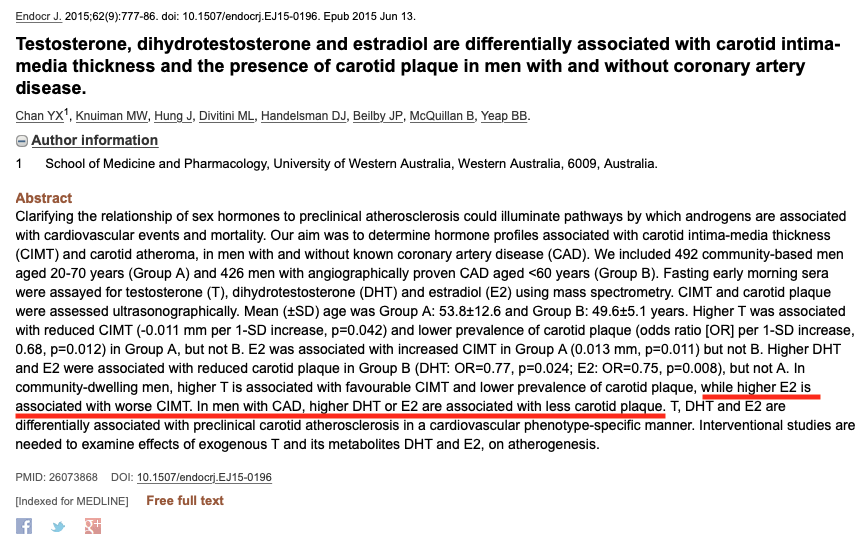Carotid Intima-Media Thickness (CIMT) Positive Negated By High E2
Once levels reach saturation some of your testosterone is converted to E2, it is simply spillover. So we mentioned earlier that we suspect E2 to be the phantom culprit in the prior confusion of whether or not testosterone gives you prostate cancer but is it healthy for the heart? It has long been suspected that increased E2 can lead to high blood pressure or water retention, especially edema in the ankles but there is not a lot of literature confirming this. This is because the sparse literature on testosterone replacement therapy is all done in a very conservative manor. In the clinical setting I have witnessed either increase in blood pressure or edema to be associated with high levels of E2, but naysayers say it is not actually E2 that is the culprit, and that there is no reason to correct your estradiol levels on TRT if they get too high. We wholeheartedly disagree with this absurdity.
Although the subjects in the observational study below were not on hormone therapy, we can extrapolate that increased levels of E2 even in the presence of testosterone can negate or even worsen the positive effects testosterone replacement therapy has on CIMT:
So this is very interesting, this study suggests that men who had normal T levels but high E2 were associated with a increase in carotid intima-media thickness.
CIMT refers to the carotid arteries in your neck and how thick they are. Testosterone replacement therapy has been shown to reduce thickness of these arteries in peer reviewed observational studies on men with angina or Coronary Artery Disease (CAD). If we look at the context most men were on gel or injections of T only once every 2 weeks. So FT, TT and E2 are not high in these subjects and patients levels at the time of testing were well within physiological range.
The study suggests that this positive effect is negated, and thickness gets worse when E2 levels are high and in the presence or normal testosterone levels, but it also showed that a increase in E2 in men with CAD actually showed a reduction in CIMT. So what gives why are there 2 different results here?
The group that already had CAD showed positive effect from “higher” levels of E2 not “high levels” of E2. So what the researchers are saying here is that men who already had low testosterone and low E2 benefited from a increase in E because they had deficient hormone levels to begin with. So just like testosterone there is a specific optimal range at which E2 benefits you health wise. The literature suggests that in “normal men” meaning they had normal levels of testosterone, that high E2 was associated with a increase or negative impact in CIMT. The study does not mention supraphysiological range so there is no reason to believe that E2 ever reached levels above threshold, but based on a diurnal rhythm and the fact we know that testosterone and therefore E2 fluctuates daily, we can extrapolate that consistent higher levels of E2, in the presence of normal levels of testosterone increases your risk of increased CIMT and negates the positive effect testosterone therapy has on your heart when properly managed.
